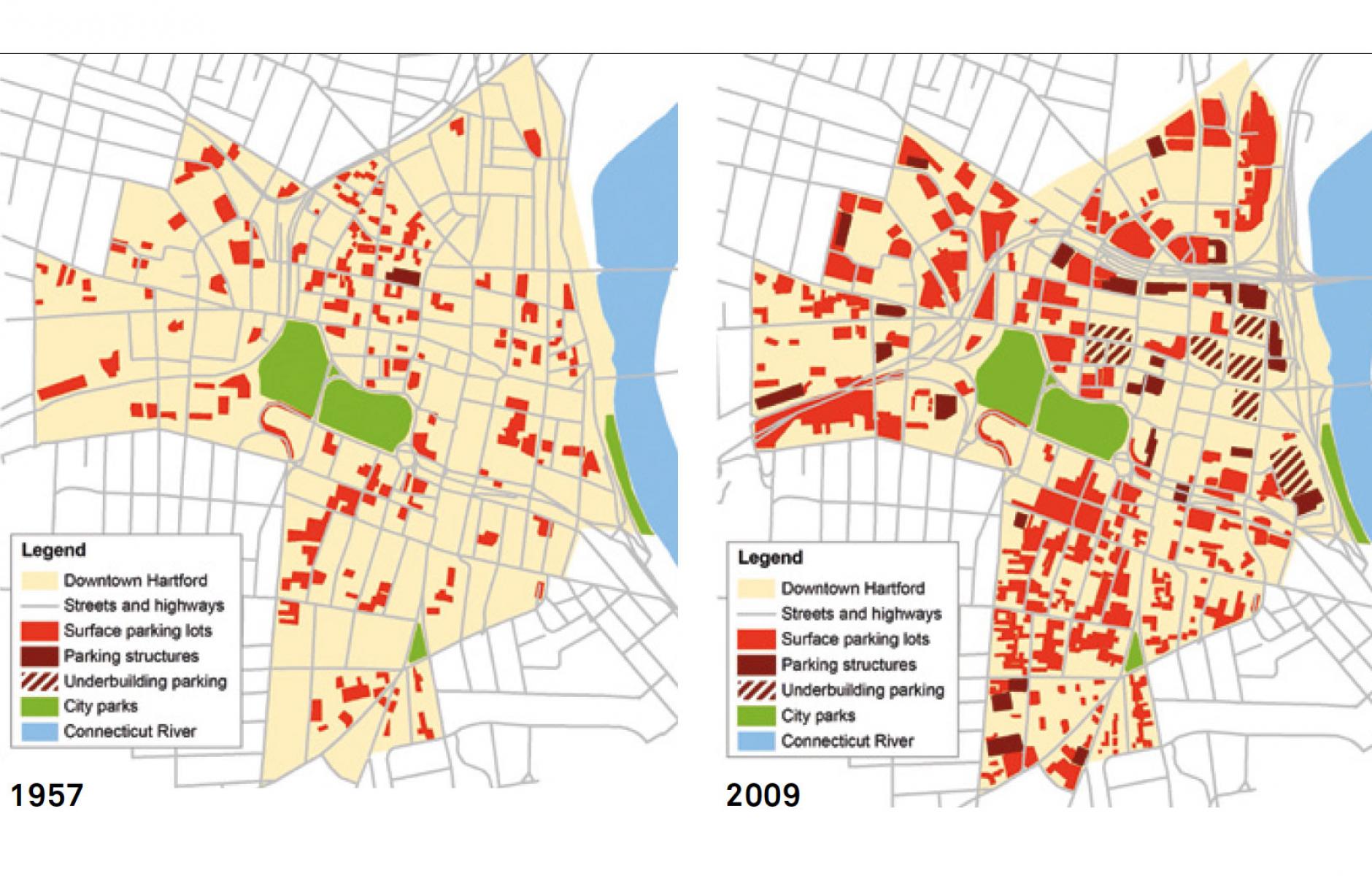
Much of its downtown gone, Hartford leads the way to parking reform
Like many industrial cities in the United States, Hartford saw dramatic population decline during the second half of the 20th century. In 1960, half of the people working in Hartford lived there, many walking or taking transit to jobs downtown; by 1980, less than a quarter of its workforce called the city home. Many white residents had fled for the suburbs and the overall population was declining. The repercussions of this demographic and economic shift are visible in the city’s bounty of parking lots: to accommodate the increase in car commuters, the city essentially paved over swaths of its downtown.
As historian Daniel Sterner put it, “Hartford is famous for having so much torn down.” Not even the city’s first skyscraper, built in 1912, survived the demolition boom. It was razed to make way for a taller office tower, but those plans were abandoned in 1990 as the country entered a recession. The prominent corner lot became, and remains, surface parking.
University of Connecticut professor Norman Garrick and his team found that from 1960 to 2000, the amount of land dedicated to parking lots in the downtown business district tripled, nearly equaling the amount of land underneath all the adjacent buildings. “The increase in parking was part of the collapse of the city,” Garrick said. “It’s typical of a lot of American cities.”
Even without the research, there was little debate that Hartford had an oversupply of parking. “I don’t think every city needs a full-on parking history, or parking analysis,” said Sara Bronin, former chair of the Hartford, Connecticut, Planning and Zoning Commission. “Most people should be able to just look around and say, ‘there’s a lot of parking in this city.’”
The overabundance of parking came at a great cost for the city, Garrick’s team found in a report released in 2014. They estimated that the city was missing out on property tax revenue to the tune of $1,200 per downtown parking space, or about $50 million a year. That was a significant amount for a city whose downtown buildings were generating $75 million in annual tax revenue.
Attracting investment is critically important for Connecticut’s capital city—and particularly challenging. More than half of the city’s real estate is nontaxable, because the land is owned by the government or nonprofit institutions. The rest is subject to the highest property tax rate in the state. Eliminating parking requirements citywide is one way to create a more flexible, inviting environment for development.
“It’s easy to say we have no parking minimums, as opposed to ‘what zone?’,” said Aaron Gill, current vice chair of Hartford’s Planning and Zoning Commission. The biggest hurdle now is convincing developers they have new options, Gill said. He encourages developers to revisit parcels they might have discounted in the past, and to review how much parking is actually being used in previous developments.
The strategy seems to be working. The quasi-public Capital Region Development Authority (CRDA) has funded more than 2,800 new homes downtown since 2012, aiming to build a critical mass of residents to support retail and other services. Mike Freimuth, executive director of the CRDA, said the new zoning code has helped reduce costs and increased the use of existing parking garages.
One of the CRDA projects, Teachers Village, involved converting an office building that had been vacant for 20 years into housing for area educators. Thirty percent of the apartments were designated as affordable. Prior to the code change, more than one parking space would have been required for each unit, but the renovated building has only 18 underground parking spaces for 60 households. The spaces are leased separately from the apartments, saving money for those who don’t need a parking spot. According to estimates based on 2016 Census data, more than 30 percent of Hartford households don’t even own a car.
Other redevelopment projects have cut deals with adjacent parking garages, which are also adapting to the new world of remote work, to provide an off-street parking option for residents for an additional fee. Two derelict commercial buildings on Pearl Street, which Freimuth used to joke were the largest pigeon coops in the state, went that route when the buildings were renovated into 258 new homes. A few blocks away, a former Steiger’s department store is being converted into 97 new apartments with commercial space below.
The CRDA is also involved in an ambitious project known as Bushnell South, which aims to convert a 20-acre area dominated by surface parking into a vibrant, walkable, mixed-use neighborhood with up to 1,200 apartments and townhouses, restaurants and retail, green space, and cultural attractions. The city was reviewing proposals from developers this summer with the goal of moving forward this fall. Although some developers have expressed concern that the city is building more residential space than the market can support, Freimuth is eager to proceed. “This land has been laying fallow for 50 years,” he told the Hartford Courant. “Why do we have to keep on waiting?”
This is Part Two in a special four-part Public Square series that highlights the growing wave of parking reform. © 2022. Lincoln Institute of Land Policy. From Shifting Gears Why Communities Are Eliminating Off-Street Parking Requirements—and What Comes Next, Catie Gould. Land Lines October 2022. Find the original article here.



